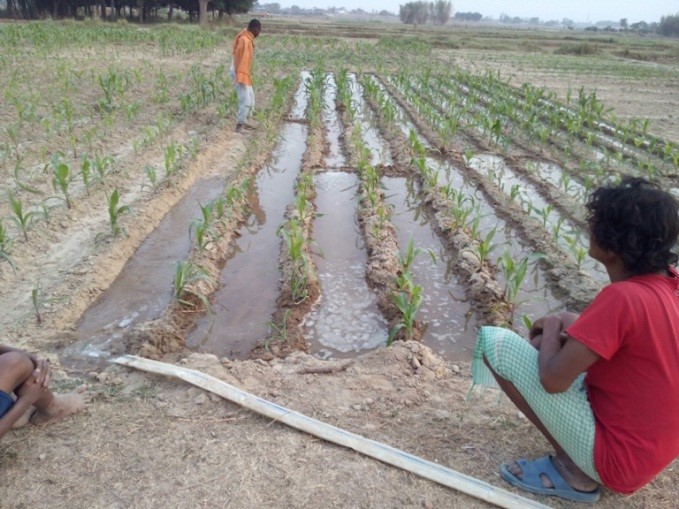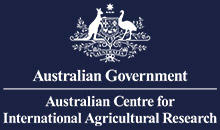By Raj Kumar and Rabindra Karki
Introduction:
Technical, social and economic constraints are limiting the effective use of groundwater and ponds for irrigation in many parts of the EGP as a result large areas of land remain fallow during the dry months. Therefore, access to year-round water for irrigation would significantly improve the agricultural productivity, improving incomes and food security.
Marginal and tenant farmers, youth and women are particularly vulnerable and could benefit from a new approach to delivery water for irrigation. The presented project aims to research and demonstrate improved collective farming systems for marginal farmers along with improved water management and irrigation practices using efficient systems which is well suited to the needs of the marginal farmer communities.
A project funded by the Australian Centre for International Agricultural Research (ACIAR) is working with communities across Nepal (Saptari), India (Cooch Behar and Madhubani) and North West Bangladesh to research and demonstrate sustainable social and biophysical interventions.
Village:
Kanakpatti is a village in Khoksarparbaha Village Development Committee (VDC), a part of Shambhunath Municipality sitting at the centre-northern part of Saptari District. It is located about one Kilometre from the main highway (Mahindra Highway). The community has different ethnic groups such Tharu, Muslim, Dalit etc. The main sources of income for these communities are remittance and agriculture except for the Dalit community whose livelihoods depend on labour wages and firewood collection from the Churiya hill. These Dalits are found to take loans from local micro-finances and co-operatives during special occasions such as festivals and weddings of their family members. They do not have their own agricultural land and have very little knowledge of agriculture. Most of the lands in Khoksar Prabaha are rain fed and as a result they remain barren in dry season owing to the lack of irrigation cannels and limited ground water potential. There are two community ponds and a private pond in the village which are filled with rain water and runoff water during monsoon (June- August). However, these ponds fed with monsoon runoff can only supply water for a limited period of 1-2 months to irrigate at most 2-3 ha of land after which the ponds dry out and the land remains fallow for the rest of the year. Only few people in areas with potential groundwater use small electric pumps (0.5 -1.5 hp) for drawing ground water for agricultural purposes.
Dalit Community and the Project Interventions:
A farmer group has been formed within the Dalit community under the project called “Gadhi Mai farmer group”. This group has 8 members – 5 males and 3 females. None of these farmers hold their own land. The group has leased 12.5 Kathha (0.42 ha) of land from Mr. Surendra Prasad Gupta for agriculture. The project facilitated the leasing agreement between the landlord and the Dalit group. The lease agreement is for two years with annual pay back of 14 maan/biagaha (560kg of paddy/ 0.67 ha). Since the land was barren for a decade it was dry, hard and tough to plough. Bullock ploughing was difficult due to high draft required to till the soil. Therefore, the project supported on land preparation/ land development efforts such as primary ploughing, land levelling and preparation. Unnecessary bunds/boarder were removed and levelled, weed were removed using manual labour and the land was prepared for crop cultivation. Furthermore, the project constantly supported the group through trainings related to agriculture and crop production, water management and capacity/leadership development. The group also observed a project site in Madhubani, India where they learned how the farmers coordinated and worked collectively (the farmers shared irrigation system, procure agriculture inputs together and work together in the farm) among themselves. Following the visit, Saptari farmers showed deep interest in adopting similar model. They showed deep concerns and reported the importance of right diversion of labour and mutual trust among the farmers for the model to be successful, which was the case in Madhubani.
Access of reliable irrigation system was the key need of the Dalit farmers. Therefore, a single phase operated 1.5 Hp electric pump was installed in the site. The pump has a discharge of 2.4 lps which provides sufficient water to irrigate 12.5 Kattha (0.42 Ha) of land all year round. Currently, the farmers have built furrows to improve the efficiency of water for irrigation and flat hose pipe is being used to deliver water from the pump to each of the farming plots.
Additionally, a sunflower solar pump has also been installed in the site. The pump irrigates lands up 0.15 Ha and also provides complement to the electric pump. The solar pump is the most beneficial option to irrigate the fields because of the erratic behaviour of electricity and frequent power cuts. The project has also established a saving and credit system as a result each farmer has started saving NPR. 100 per month.
Impact:
After having access to irrigation, and receiving relevant training, farmers have been able to grow different vegetable and corns in different seasons. The agricultural production following barren lands for several years due to lack of irrigation has proven to be a great success. As of date, the famers are harvesting vegetables and selling them in the local market. Corns too will soon be ready to be harvested in a few weeks. In our meeting with the groups, we were informed that they were consuming more vegetables than in the past. The irrigation pump is being used collectively and they have developed a routine for sharing water.
The group is slowly understanding the project approach because of the continuous engagement of group in the project activities and capacity development trainings. These trainings have focused on leadership development and capacity building for working collectively.
However, there are three key challenges observed so far which are:
- The group farmers are not willing to abandon their traditional occupations which include wage labour and fire wood collection as it provides a quick return to meet their daily needs,
- The farmers have very limited understanding and interest in farming, and
- The lands are very firm and not as fertile mainly due to remaining fallow/uncultivated for many years. A recent laboratory test revealed that the soil fertility is poor due to deficiency of micro nutrients and high acidity.
Future:
The project will develop action plans to address the challenges outlined above and implement the scheduled activities for the group.
- The project will mobilise the farmer group to improve each farmer’s interest on agriculture in order to keep them fixated on agriculture by providing an opportunity to realise agriculture return and benefits.
- As a regular program, the project will:
- Provide training on improved agriculture practices, water management and capacity development,
- Set up collective farming system and
- Mobilise farmers to establish pump the repair and maintenance funds and develop local capacity for the pumps repairs.
- With support from agricultural experts and soil scientists, a set of measures are planned and implemented to improve the soil fertility.
- The project aims to increase the area of leased land. It also aims to train and encourage farmers to grow high value crops that could maximise their income reducing their dependency on traditional occupations.







